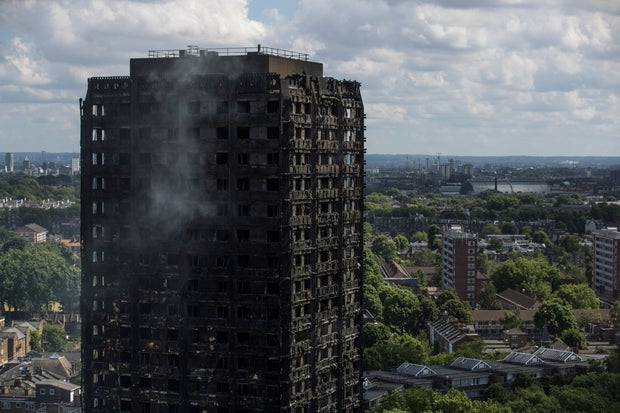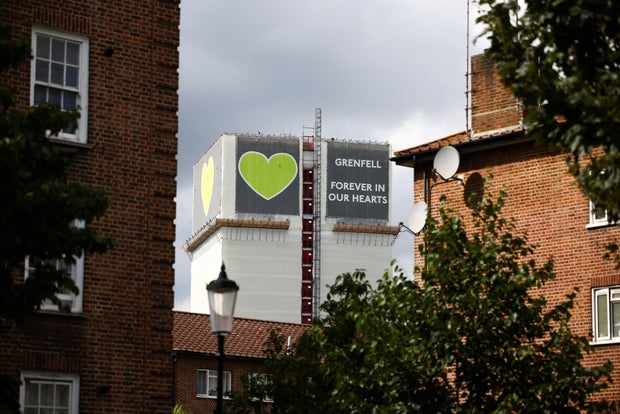CBS News
Grenfell Tower fire inquiry says U.S. company Arconic “deliberately concealed” dangers of building materials

London – The public inquiry into the deadly 2017 fire that engulfed Grenfell Tower, a high-rise public housing apartment building in central London, published its final report Wednesday on the disaster that killed 72 people. The blaze — London’s deadliest since World War II — was blamed on a litany of failures, from shoddy construction and materials to poor local management and inadequate fire safety standards.
Among the parties found to have played a role in the tragedy by the inquiry is the American company Arconic, which made and sold the building’s exterior cladding through a French subsidiary.
The report’s authors said the Pittsburgh-based company “deliberately concealed from the market the true extent of the danger of using” the materials that were added to Grenfell Tower during a renovation, “particularly on high-rise buildings.”
Dan Kitwood/Getty
“By late 2007 Arconic had become aware that there was serious concern in the construction industry about the safety of ACM panels and had itself recognized the danger they posed,” the report says. “By the summer of 2011 it was well aware that Reynobond 55 PE in cassette form [the material used on Grenfell Tower] performed much worse in a fire and was considerably more dangerous than in riveted form. Nonetheless, it was determined to exploit what it saw as weak regulatory regimes in certain countries (including the UK) to sell Reynobond 55 PE in cassette form, including for use on residential buildings.”
CBS News has asked Arconic to comment on the allegations laid out in the report published Wednesday.
Ongoing inquiry
Earlier phases of the multi-year inquiry concluded that some of the companies that manufactured the materials used in the cladding on Grenfell Tower, including Arconic, continued to market their products as safe, despite some employees knowing they were flammable.
Emails shared with the inquiry appeared to show that some Arconic employees knew of the fire risk associated with the cladding used on Grenfell Tower, but that the company continued to sell it anyway.
When approached in 2021 about whether its employees knew about the fire risks associated with Arconic’s cladding, Arconic told CBS News it was “continuing to offer their full support to the authorities as the inquiry works through the complex questions presented. It is not appropriate for us to comment further while the Inquiry is ongoing and before all evidence has been presented in Phase Two.”
HENRY NICHOLLS/AFP/Getty
“These corporations are still operating as if nothing has happened,” Karim Mussilhy, whose uncle was killed in the fire, told CBS News in 2021.
In the wake of the deadly blaze, apartment buildings across the U.K. that were covered in the same or similar external cladding materials were found to be unsafe, leaving thousands of people trapped in dangerous homes and unable to sell because banks won’t provide new mortgages on the properties in question.
“People should be safe in their homes. People shouldn’t have to feel like they’re going to sleep and not knowing if they’re going to wake up or not,” Mussilhy said in 2021.
Victims still seeking justice
The Grenfell Inquiry launched with a first hearing on Sept.14, 2017. The families of some victims and survivors said they’ve been denied justice as it’s gone on.
“It’s meant criminal prosecutions couldn’t have happened,” said Nazanin Aghlani, whose mother Sakina Afrasehabi was killed in the fire. She told CBS News’ partner network BBC News that prosecutions should have happened before the public inquiry.
She said the inquiry had even given “all those people that should be facing criminal prosecutions” a platform “to tell their version of the story.”
London’s Metropolitan Police said in May that no criminal prosecutions related to the Grenfell fire would begin until 2026, according to the BBC. The police were expected to make a statement later Wednesday.
“We’ve been waiting seven years to find out the facts, that are gonna be in black and white,” Nick Burton, who was rescued from the 19th floor of the tower, told the BBC, hoping the report would “tell the truth about these corporations and their part that they played in the fire.”
“We need to know who is actually accountable, who actually made the decisions that led to this horror and who can actually be pinned down and charged,” Emma Dent Coad, a former member of parliament for London’s central Kensington district, told the BBC.
CBS News
House to vote on Mike Johnson’s spending plan to avoid a government shutdown

Watch CBS News
Be the first to know
Get browser notifications for breaking news, live events, and exclusive reporting.
CBS News
How much will an $850,000 mortgage cost per month?

Getty Images
Even though mortgage interest rates surged in recent years, they did little to drop home values. Instead, home prices have remained steady and even grown in many parts of the country. Now, with a major cut to the federal funds rate already issued and additional ones possible for the months ahead, prices could rise again as sellers try to take advantage of a wider pool of buyers. Homes that had been priced in the $700,000 range, for example, could now be around $800,000 or $850,000. And homes priced at $1 million or more are already growing.
Understanding this reality, then, buyers should start preparing for higher home prices now. One of the best ways to do so is by calculating the potential monthly costs of a mortgage loan. Below, we’ll detail what an $850,000 mortgage will cost per month – and what it could look like if interest rates decline as anticipated.
See what mortgage interest rate you could lock in here now.
How much will a $850,000 mortgage cost per month?
The average mortgage rate on a 30-year mortgage dropped to 6.15% this week, the lowest it’s been in two years (September 2022). But with rate cuts possible for November and when the Fed meets again in December that rate could fall again before the year ends – assuming lenders don’t start pricing in a series of presumed rate cuts to come.
Here’s what an $850,000 mortgage loan would cost per month at the rate available today, assuming the conventional 20% down payment ($170,000), minus any taxes or insurance costs:
- 30-year mortgage at 6.15%: $4,142.75 per month
- 15-year mortgage at 5.65%: $5,610.44 per month
While today’s mortgage rates aren’t likely to fall directly in tandem with the federal funds rate, a half a percentage point reduction seems possible now following the Fed’s moves this week. Here’s what those payments could fall to assuming a half a percentage point reduction between now and January.
- 30-year mortgage at 5.65%: $3,925.20 per month
- 15-year mortgage at 5.15%: $5,430.68 per month
It’s important to remember, however, that mortgage interest rates change daily (except for weekends and holidays). And in today’s evolving rate climate, these rates could fall even further than many anticipate, thus making an $850,000 mortgage loan even more affordable. So keep an eye on the market and be prepared to lock in a low rate when found.
Start shopping for rates and lenders here now.
Other factors to account for
While the above numbers reflect what buyers can expect to pay for an $850,000 mortgage now (and after a rate reduction of half a percentage point), they’re not the only factor that should be added in when trying to pinpoint your exact monthly mortgage payment. Specifically, don’t forget:
- Homeowners insurance: The bank will want their loan protected and you’ll want to be insured against theft, damage and injuries. Start shopping around now to find the best deal and consider “bundling” any policy with your car insurance to reduce costs.
- Flood insurance: Depending on where your home is located, the lender may require flood insurance proof before signing off on the loan. So be sure to ask if the home is located in a flood zone and ask if you can assume the existing policy, if applicable.
- Taxes: Taxes could be paid annually or you can have them divided among your monthly mortgage payments but this could be a significant amount of money to account for so be sure to determine the exact cost before closing, and, ideally, before making a formal offer.
- Private mortgage insurance: Don’t have enough money to make the conventional 20% down payment? Then you’ll have to pay private mortgage insurance, or PMI, to your lender until you’ve reached that equity threshold.
The bottom line
The Fed’s rate cuts could make the monthly payments on an $850,000 mortgage a lot more affordable, but navigating the current real estate market still requires careful consideration of a range of factors. As interest rates fluctuate and home prices adjust, the market could shift, and potential buyers may want to stay informed about trends but also thoroughly calculate all associated costs during the process. That way, they can make more confident decisions about their path to homeownership.
CBS News
Here’s how the Fed’s big rate cut affects mortgages

Getty Images
The mortgage rate landscape is undergoing a rapid transformation now that inflation is cooling. For starters, there has been a notable drop in mortgage rates over the past few weeks, with rates hitting a two-year low on Wednesday. This shift has already begun to stir excitement, as more affordable borrowing costs open doors for those previously priced out of homeownership.
The Federal Reserve also conducted its first rate cut since 2020 (September 18), reducing the federal funds rate by an unexpected 50 basis points. Most analysts expected the Fed rate cut to be just 25 basis points, making this decision larger and more impactful than anticipated.
This move is expected to put additional downward pressure on interest rates across the board, including mortgages, and may present an opportunity for borrowers to lock in more favorable rates. But how exactly will this substantial Fed rate cut impact mortgages? Below, we’ll break down what you should know.
See how low of a mortgage rate you could lock in here today.
Here’s how the Fed’s big rate cut affects mortgages
The Federal Reserve’s decision to implement a 50 basis point rate cut has injected a new layer of complexity into the mortgage market. While the impact of a standard 25 basis point reduction has likely been factored into current mortgage rates, which are sitting at an average of 6.15%, it’s unclear exactly how mortgage rates will respond to this larger rate cut.
One outcome could be that the larger rate cut will cause mortgage rates to fall even further in the coming days and weeks, building on the recent trend of declining rates. This could create a more favorable environment for borrowers, with the possibility of mortgage rates dipping to levels not seen in years.
However, it’s crucial to understand that the Federal Reserve’s actions, while significant, are not the sole factor influencing mortgage rates. The mortgage market is a complex ecosystem affected by various economic indicators. Long-term bonds, particularly the 10-year Treasury yield, also play a pivotal role in determining mortgage rates. So while the Fed’s rate cut will likely push these yields lower, other factors can also sway bond yields and, consequently, mortgage rates.
The mortgage industry itself may also play a role in tempering any dramatic rate drops. For example, lenders might be hesitant to lower rates too quickly or too far as they balance their desire to attract borrowers with the need to maintain profitability. This could result in a more gradual decline in mortgage rates rather than an immediate, sharp drop.
For potential homebuyers or those considering refinancing, the Fed’s larger-than-expected rate cut presents both opportunities and potential challenges. On one hand, the prospect of lower mortgage rates is certainly appealing. Lower rates translate to more affordable monthly payments and increased buying power, potentially allowing borrowers to qualify for larger loans or more desirable properties.
The allure of lower rates could also bring its own set of complications, however. If mortgage rates decline even further, it’s likely to attract more buyers to the market. This increased demand could lead to heightened competition for available properties, potentially driving up home prices and offsetting some of the benefits of lower interest rates.
Those waiting for rates to bottom out before making a move may also find themselves in a precarious position. Timing the market is notoriously difficult, and there’s a risk that rates could begin to rise again before you can act. After all, economic conditions can shift rapidly, which could reverse the current downward trend in rates.
Lenders are also more likely to see an uptick in inquiries and applications in the wake of the Fed’s decision. This increased volume could lead to longer processing times and potentially stricter underwriting standards, so borrowers should be prepared for this possibility and consider getting pre-approved or starting the application process early.
Find out how low your mortgage loan rate could be now.
The bottom line
The Federal Reserve’s unexpected 50 basis point rate cut will likely have a noticeable effect on the mortgage market, but its exact impact remains uncertain. While lower rates may materialize in the short term, a range of factors will influence how mortgage rates move in the future. So, homebuyers and homeowners who plan to refinance should carefully consider their options, recognizing that waiting for the perfect moment could be risky in an unpredictable market. Securing a favorable rate now may be the best course of action instead, especially with rates already at a two-year low.











